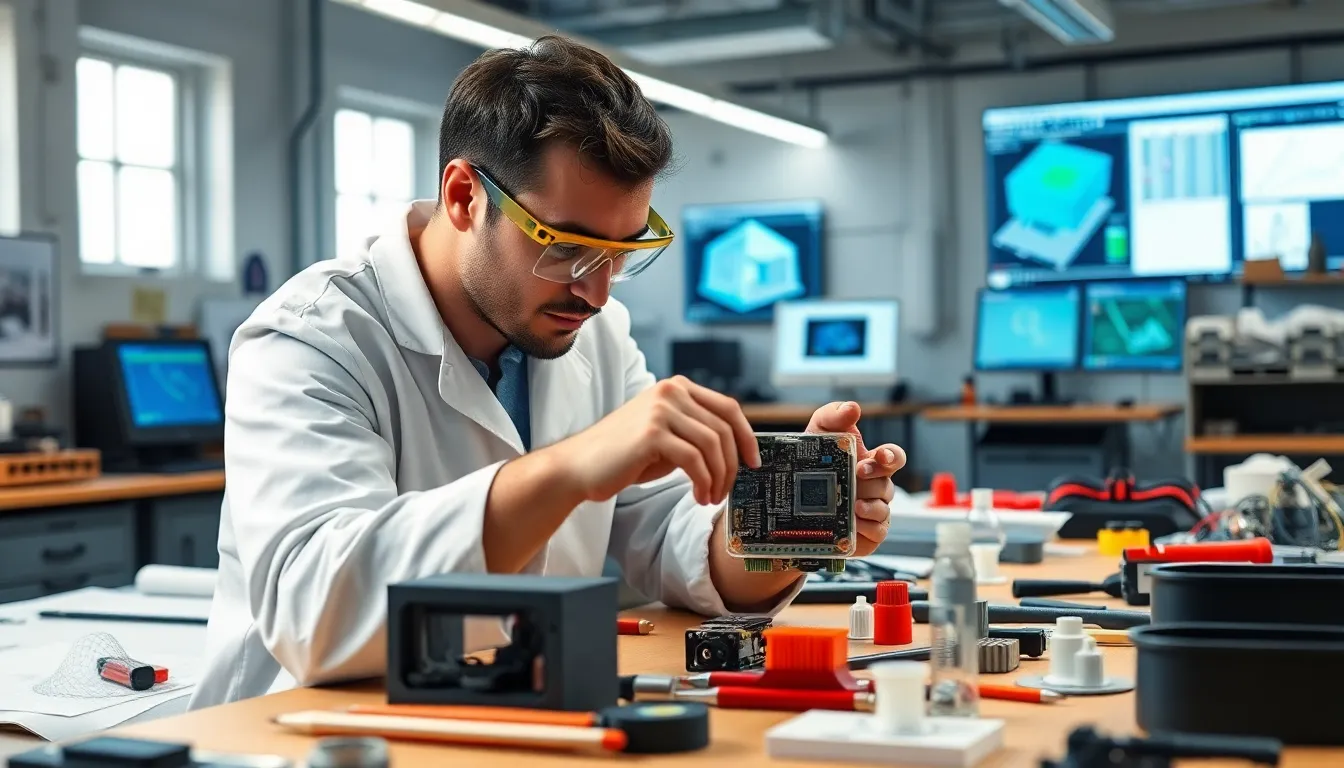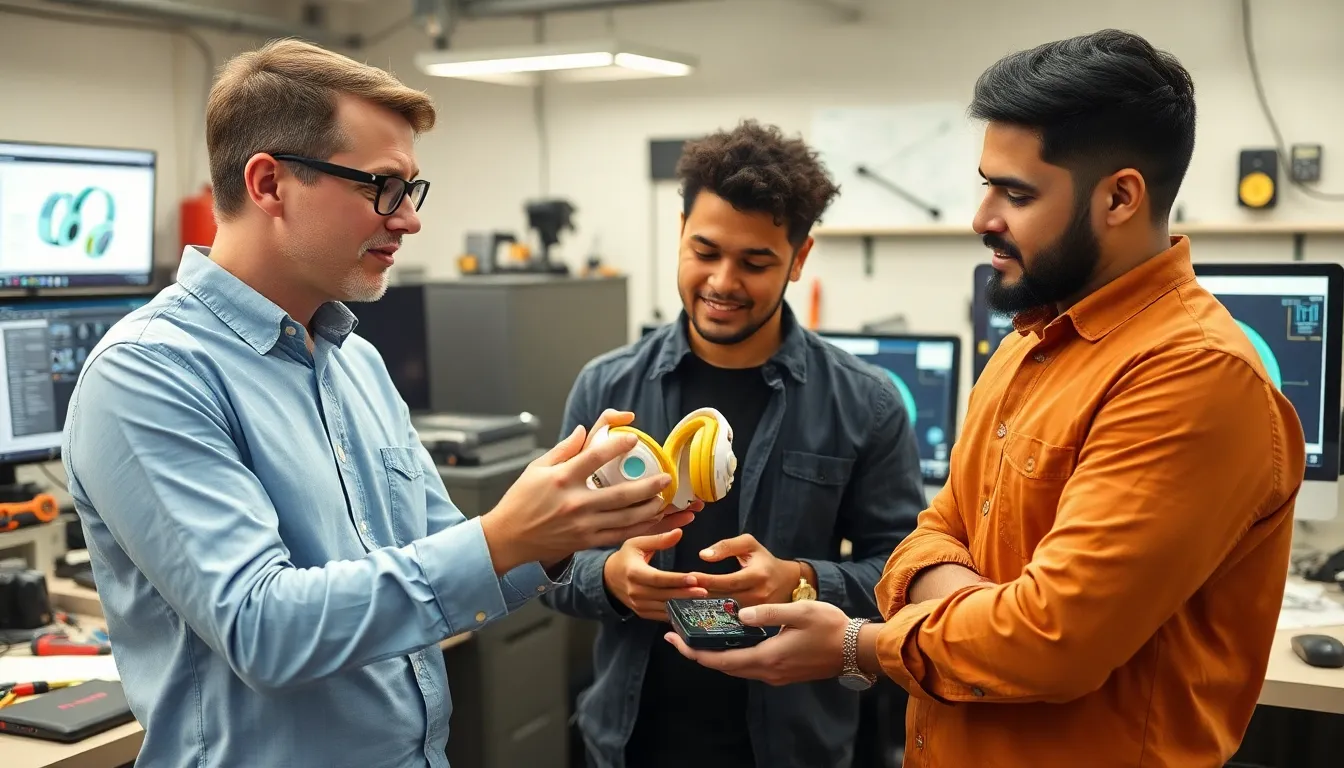In a world where gadgets seem to multiply faster than rabbits, consumer electronics engineering services are the unsung heroes ensuring that our tech doesn’t just look good but works like a charm. From smartphones to smart fridges, these engineering wizards blend creativity with technical prowess to turn wild ideas into reality.
Imagine a world where your toaster can tell you when it’s done, or your headphones can read your mood. Sounds like sci-fi? Not anymore! With the right engineering services, these futuristic fantasies can become part of everyday life. So, buckle up as we dive into the fascinating realm of consumer electronics engineering, where innovation meets practicality, and every device gets a touch of magic.
Table of Contents
ToggleOverview of Consumer Electronics Engineering Services
Consumer electronics engineering services focus on transforming concepts into market-ready products. These services encompass a range of areas, including product design, prototyping, testing, and production. Engineers in this field utilize their expertise to ensure products meet consumer needs and adhere to regulatory standards.
Key Areas of Focus:
- Product Design: Engineers create innovative designs that prioritize usability and aesthetics. They incorporate user feedback during the design phase to enhance functionality.
- Prototyping: Rapid prototyping allows teams to create and test models quickly, identifying potential issues before full-scale production. This step is crucial for refining product features and performance.
- Testing and Validation: Rigorous testing ensures products function as intended. Engineers perform various tests, including safety, performance, and reliability assessments, to validate product quality.
- Manufacturing Support: Engineering services extend to assisting with manufacturing processes. By optimizing production techniques, engineers help reduce costs and improve efficiency while maintaining product integrity.
Emerging Technologies:
Consumer electronics engineering services adapt to technological advancements. Innovations, such as the Internet of Things (IoT), artificial intelligence (AI), and smart devices, drive the current landscape. Engineers incorporate these elements into products, enhancing interactivity and user experience.
Consumer Engagement:
Effective engineering services prioritize understanding consumer behavior. Engaging with consumers provides insights into preferences and pain points. Engineers leverage this information to create products that resonate with users and address their needs.
By combining technical skills and creativity, consumer electronics engineering services play a pivotal role in developing the next generation of smart devices and gadgets. This collaboration between engineering and market understanding shapes how technology integrates into everyday life.
Importance of Consumer Electronics Engineering Services

Consumer electronics engineering services play a crucial role in developing innovative technologies that meet consumer needs. These services ensure that ideas evolve into products that are not only functional but also user-friendly and market-ready.
Product Development and Prototyping
Product development and prototyping serve as the foundation for turning concepts into viable gadgets. Engineers utilize iterative design processes to refine prototypes, ensuring these gadgets meet user expectations. Rapid prototyping techniques enable quick adjustments based on feedback, minimizing time-to-market. Employing tools like 3D printing and CAD software streamlines this process, allowing for efficient visualization of designs and functions. As a result, engineers can identify issues early, optimizing product design and performance before mass production.
Compliance and Testing
Compliance and testing ensure consumer electronics meet safety and quality standards. Engineers conduct rigorous testing to evaluate performance under various conditions, addressing potential failures before market launch. Adherence to industry regulations like CE, FCC, or RoHS is mandatory for products to gain acceptance in international markets. Through comprehensive testing protocols, engineers assess functionality, durability, and user safety. This commitment to quality reassures consumers and helps establish brand credibility.
Key Areas of Expertise
Consumer electronics engineering services encompass several key areas that contribute to the development of innovative products. These areas include hardware design, software development, and embedded systems.
Hardware Design
Hardware design focuses on creating physical components of electronic devices. Engineers prioritize functionality, durability, and user experience when designing hardware. They utilize computer-aided design (CAD) tools for precise modeling, ensuring that components fit together seamlessly. Materials selection is crucial for enhancing performance and aesthetics. Manufacturers often rely on prototypes to validate hardware designs early, minimizing production costs and time. Additionally, adherence to industry standards guarantees that products are safe and compliant, addressing market needs effectively.
Software Development
Software development involves programming the applications and systems that power consumer electronics. Engineers design user-friendly interfaces that enhance interaction with devices. They apply agile methodologies to create responsive software, allowing for iterative improvements based on user feedback. Integration of features like connectivity and data processing ensures devices meet modern demands. Security also plays a vital role, requiring developers to embed robust safeguards against vulnerabilities. Testing phases focus on performance and usability, ensuring software aligns with hardware capabilities for a cohesive user experience.
Embedded Systems
Embedded systems play a crucial role in the functionality of consumer electronics. Engineers design these systems to operate hardware and manage tasks autonomously. Real-time processing capabilities ensure devices respond promptly to user commands and environmental changes. Engineers select appropriate microcontrollers and sensors to optimize performance. Additionally, cross-functional collaboration with software teams guarantees that embedded systems and applications work together smoothly. Effective testing and validation of embedded systems ensure reliability, an essential aspect for consumer acceptance and product success.
Trends in Consumer Electronics Engineering
Consumer electronics engineering continues to evolve rapidly, driven by technological advancements and changing consumer preferences.
IoT Integration
IoT integration remains a key trend in consumer electronics engineering. Engineers focus on embedding connectivity into devices, enabling interoperability between products. Smart home solutions, like connected thermostats and security cameras, exemplify this trend. Devices use cloud computing to enhance user interaction and data analytics. Moreover, engineers design products that support voice command functionalities and integrate with popular platforms such as Google Assistant and Amazon Alexa. This seamless connectivity allows users to manage multiple devices effortlessly, elevating the overall consumer experience.
Sustainable Design Practices
Sustainable design practices in consumer electronics engineering are gaining traction. Engineers prioritize environmentally friendly materials and energy-efficient technologies to minimize ecological impact. They implement designs that allow easy recyclability and end-of-life product management. Additionally, adherence to regulatory standards regarding waste reduction shapes the development process. For instance, engineers explore biodegradable plastics and sustainable supply chains to enhance product sustainability. This focus on eco-conscious practices aligns with growing consumer demand for environmentally responsible products and reinforces brand loyalty in a competitive market.
Challenges in Consumer Electronics Engineering
Consumer electronics engineering faces several challenges that impact product development and market success.
Rapid Technological Changes
Rapid technological changes demand engineers adapt quickly to new innovations and industry standards. Emerging technologies, like artificial intelligence and machine learning, require continuous learning to integrate advanced features into consumer electronics. Additionally, short product life cycles pressure engineers to streamline design processes and prioritize speed without compromising quality. Staying updated on trends ensures products remain relevant and competitive in a constantly evolving landscape.
Market Competition
Market competition in consumer electronics drives the need for differentiation and innovation. Numerous brands vie for consumer attention, necessitating unique features and enhanced user experiences. Cost-effective production methods also become essential to maintain profit margins. To stay ahead, engineers must focus on user-centric design, incorporating feedback throughout development. Competitive analysis further informs strategies to navigate saturated markets, enabling companies to tailor products to meet specific consumer demands effectively.
Consumer electronics engineering services are pivotal in shaping the future of technology. By merging creativity with technical expertise, engineers are turning visionary concepts into tangible products that enhance daily life. Their commitment to usability, quality, and innovation ensures that the latest advancements not only meet but exceed consumer expectations.
As the industry evolves with trends like IoT and sustainable design, these engineers are well-equipped to navigate challenges and seize opportunities. Their work not only drives market competitiveness but also fosters a deeper connection between technology and users. As consumer demands continue to grow, the role of engineering services in this sector will remain crucial in delivering smart, efficient, and user-friendly devices.




